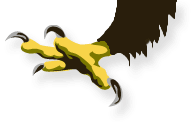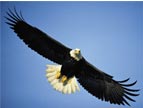Bald Eagle Program

Wildlife Research & Habitat Enhancement Permits
 Anyone wishing to conduct research on wildlife in city parks, including but not limited to: monitoring using anything other than portable, hand-held or simple free-standing equipment; trapping and/or releasing animals including invertebrates; entering closed or limited-access areas; or collecting water or soil samples; or anyone wishing to enhance wildlife habitat in city parks, including but not limited to the installation of nest boxes, MUST apply for a permit from the Department of Parks & Recreation Urban Park Rangers. This permit is in addition to any permits required by Federal and/or State Agencies with jurisdiction over the wildlife being studied, and also any other Department of Parks & Recreation permits from other Offices or Divisions.
Anyone wishing to conduct research on wildlife in city parks, including but not limited to: monitoring using anything other than portable, hand-held or simple free-standing equipment; trapping and/or releasing animals including invertebrates; entering closed or limited-access areas; or collecting water or soil samples; or anyone wishing to enhance wildlife habitat in city parks, including but not limited to the installation of nest boxes, MUST apply for a permit from the Department of Parks & Recreation Urban Park Rangers. This permit is in addition to any permits required by Federal and/or State Agencies with jurisdiction over the wildlife being studied, and also any other Department of Parks & Recreation permits from other Offices or Divisions.
For more information on how to apply for a permit, please contact the Rangers at (212) 360-2774 or by email using the Rangers contact form.
About Inwood Hill Park
Inwood Hill Park contains the last natural forest and salt marsh in Manhattan. It is unclear how the park received its present name. Before becoming parkland in 1916, it was known during the Colonial and post-Revolutionary War period as Cock or Cox Hill. The name could be a variant of the Native American name for the area, Shorakapok, meaning either “the wading place,” “the edge of the river,” or “the place between the ridges.”
Human activity has been present in Inwood Hill Park from prehistoric times. Through the 17th century, Native Americans known as the Lenape (Delawares) inhabited the area. There is evidence of a main encampment along the eastern edge of the park. The Lenape relied on both the Hudson and Harlem Rivers as sources for food. Artifacts and the remains of old campfires were found in Inwood’s rock shelters, suggesting their use for shelter and temporary living quarters.
In 1954 the Peter Minuit Post of the American Legion dedicated a plaque at the southwest corner of the ballfield (at 214th Street) to mark the location of a historic tree and a legendary real estate transaction. A living link with the local Indians who resided in the area, a magnificent tulip tree stood and grew on that site for 280 years until its death in 1938. The marker also honors Peter Minuit’s reputed purchase of Manhattan from the Lenape in 1626. The celebrated sale has also been linked to sites in Lower Manhattan.
In the 17th and 18th centuries, colonists from Europe settled and farmed here. During the Revolutionary War, American forces built a five-sided earthwork fort (known as Fort Cock or Fort Cox) in the northwestern corner of the park. It fell to British and Hessian troops in November 1776 and was held until the war ended in 1783. After the Revolutionary War, families returned to the area to resume farming.
In the 1800s much of present-day Inwood Hill Park contained country homes and philanthropic institutions. There was a charity house for women, and a free public library (later the Dyckman Institute) was formed. The Straus family (who owned Macy’s) enjoyed a country estate in Inwood; its foundation is still present. Isidor and Ida Straus lost their lives on the S.S. Titanic’s maiden voyage. When the Department of Parks bought land for the park in 1916, the salt marsh was saved and landscaped; a portion of the marsh was later landfilled. The buildings on the property were demolished. During the Depression the City employed WPA workers to build many of the roads and trails of Inwood Hill Park.
In 1992 Council Member Stanley E. Michels introduced legislation, which was enacted, to name the natural areas of Inwood Hill Park “Shorakapok” in honor of the Lenape who once resided here. In 1995 the Inwood Hill Park Urban Ecology Center was opened. It provides information to the public about the natural and cultural history of this beautiful park. Today the Urban Park Rangers work with school children on restoration projects to improve the health and appearance of the park. Complementing the work of the Rangers is that of dozens of Inwood “Vols” (Volunteers), who assist with park restoration and beautification.

About Bald Eagles
Welcome Back Bald Eagles!
Bald Eagles ( Haliaetus leucocephalus) in New York City.
Prepared by the Urban Park Rangers.
During the past decade the State of New York has been committed to restoring the Hudson River and its estuary. At the same time, New York City has undertaken an equivalent investment in rebuilding the various ecosystems that grace its parks. The re-introduction and restoration of the Bald Eagle to New York City will hopefully prove to be a capstone these combined efforts and a symbolic salute to the events of 2001.
Bald Eagles used to be far more common in the New York City area, and they clearly used to be common near the Hudson River’s estuary. As late as the 1840s there were still 60-70 eagles found on Long Island each winter, and at least one pair still bred on the eastern end as a late as 1930. Closer to the City the last nest was in Westchester County in 1890. However, the major factors behind their decline (i.e., hunting, egg collecting, DDT, and nest site loss) have all been regulated or addressed. Therefore, we believe now that the Hudson River has been significantly cleaned up, and the forested slopes along the river have been restored, it is time to bring back another keystone species in the area’s ecology.![]()
The BALD EAGLE in Depth
In this area Bald Eagles usually build their nests and lay their eggs by the middle of April. Incubation lasts for approximately 35 days, and both parents share in the incubation and the raising of the young. Eaglets are fed on a diet reflecting their parents’ tastes, and in a broad survey of nests, the remains of fish, ducks, other birds, and small mammals were frequently found. Fish generally constitute between seventy and ninety percent of their diet. In addition, Bald Eagles are well known as carrion feeders, and if they can pirate fish from an Osprey they will do so.
Young eagles are usually ready for their first flight by early July, and will remain in an area near their nest perfecting their skills through the summer. By September they will wander further afield, and by late fall they are clearly independent. As long as hey are able to find food, they will remain in the area. On the other hand if food is not abundant they will wander until a steady food source is found. Currently, each winter eagles are known to gather at the mouth of the Connecticut River, the Housitanic River, along the upper reaches of the Delaware River, near Niagara Falls, and in Jefferson County on the east side of Lake Ontario. We hope the Hudson River will join this list.
Bald Eagles do not mature until they are four or five years old, and this is easily marked by their acquisition of a white head and tail. On average their full wingspan is more than four feet across, and they will attack prey as large as a Canada Goose. Eagles tend to mate for life, though if one mate perishes they will find another. Their life span may covermore than thirty years.![]()
Eagle Facts:
- Adopted as National Symbol on June 20th, 1782.
- Between 1917 and 1927 41,812 eagles were shot in Alaska.
- Between 1979 and 1996 the Bald Eagle population more than tripled in N.Y. State to over 170.
- One Bald Eagle nest in Ohio was used for 35 years. The nests 12 feet high and 8 feet across at the rim. It weighed more than two tons.
Our Partners
The Bald Eagle Re-introduction program has been undertaken with a great number of partners.
This year, the Urban Park Rangers are working in association with Jim Elliott, Executive Director of the International Center for Birds of Prey.
BP has contributed a significant amount to sponsor the project, and Fairway Market is providing more than sixteen pounds of fish a day for the birds. The State of Wisconsin provided the eaglets themselves, and New York State’s Department of Environmental Conservation, and the U.S. Fish & Wildlife Service all provided advice, guidance and the requisite permits. The Parks Department’s 5-Boro Shops built the hack boxes and the platform, and the Forestry Division helped by pruning the trees near the hack site into a jungle-gym for the young birds. Finally, Park’s Natural Resources Group has devoted years to helping restore the forested slopes of Inwood Park, and the Urban Park Rangers have pioneered and pushed forward on the notion of re-introducing extirpated species back into the City’s parks.
BP
The State of Wisconsin
New York Department of Environmental Conservation
Fairway Market
International Center for Birds of Prey.
About BP
BP, one of the world's leading energy companies, is proud to sponsor the historic reintroduction of the American Bald Eagle into northern Manhattan by the New York City Parks & Recreation Department and the Urban Park Rangers.
Bringing this endangered bird to the lower Hudson River is both a real and a symbolic event in the life and revitalization of New York City. It stands for the enduring will of New Yorkers to rebuild and to reach even greater heights in the wake of tragedy.
BP is also pleased to sponsor Conservation: Keep it Green, part of the Urban Park Rangers’ Natural Classroom program. This joint initiative among the Urban Park Rangers, The National Geographic Society, and the Board of Education is designed to link New York City school children to their natural world via hands-on activities inside the parks.
BP joins all New Yorkers in raising our sights upon the awe-inspiring potential of these majestic birds to soar above this great city once again.